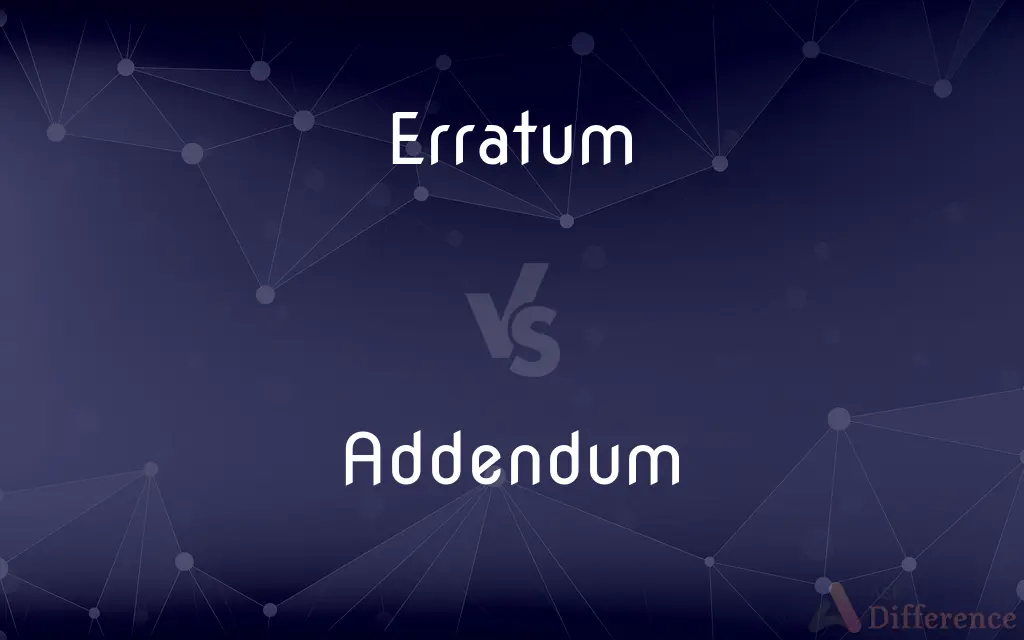Erratum vs. Addendum — What's the Difference?
By Urooj Arif & Fiza Rafique — Updated on April 8, 2024
An erratum addresses and corrects errors in a published work, while an addendum adds extra information or clarifications without correcting an error.

Difference Between Erratum and Addendum
Table of Contents
ADVERTISEMENT
Key Differences
An erratum is a note or correction made to a published text to rectify mistakes such as typographical errors, factual inaccuracies, or misprints. On the other hand, an addendum is an additional piece of information added to a text after its initial publication. It is used to include new findings, updates, or clarifications that were not initially available or considered necessary. While an erratum corrects past mistakes, an addendum enhances the document with new or supplementary information.
Errata (the plural of erratum) focus on correcting errors that could potentially mislead readers or misrepresent facts, indicating a commitment to accuracy and integrity by the publishers or authors. Conversely, addenda (the plural of addendum) serve to update a document or provide further details to the readers, enriching their understanding without necessarily correcting a past mistake. This distinction highlights the erratum’s role in maintaining the text's credibility and the addendum’s role in extending or updating its content.
In practical terms, an erratum is typically brief, directly addressing the specific error and providing the correct information. It's often listed at the beginning or end of a publication or on a dedicated webpage for digital content. An addendum, however, can vary in length and format, depending on the nature of the additional information it provides. It might appear as an appendix, a supplementary section, or a digital update to the original text.
The process of issuing an erratum involves identifying the error, deciding on the correct information, and formally communicating the correction to the audience. For an addendum, the process includes determining the relevance and significance of the new information, ensuring it aligns with the original content, and seamlessly integrating it into the existing text or accompanying it as a separate update.
While both errata and addenda are critical in scholarly, legal, and professional contexts for ensuring the accuracy and completeness of published work, they serve distinctly different purposes. The erratum corrects and clarifies to uphold the work's integrity, whereas the addendum expands and enriches the content to keep it relevant and comprehensive.
ADVERTISEMENT
Comparison Chart
Purpose
Corrects errors in a published text.
Adds information or clarification to a text.
Nature
Corrective.
Supplementary.
Examples
Typographical errors, factual inaccuracies.
Updates, additional findings, extended analysis.
Outcome
Maintains or restores accuracy and integrity.
Enhances understanding, provides updates.
Placement
Often at the beginning/end of a publication.
Can be an appendix or a separate section.
Length
Typically brief, focusing on specific corrections.
Can vary, depending on the added information.
Process
Identification of errors, formal correction.
Determination of relevance, seamless integration.
Compare with Definitions
Erratum
Often listed in a dedicated section.
The magazine's errata page addressed several minor mistakes.
Addendum
Serves as an update or extension.
The software manual’s addendum introduced new features added after the initial release.
Erratum
Reflects a commitment to integrity.
The erratum acknowledged the oversight in the experimental results.
Addendum
Can vary significantly in length.
The book's addendum featured an extended analysis of recent events.
Erratum
A correction of errors in a text.
The journal issued an erratum to correct the author's name.
Addendum
Additional material appended to a text.
The report included an addendum with the latest research findings.
Erratum
Usually applies to factual or typographical mistakes.
An erratum was published for the book's misprinted date.
Addendum
Enhances the original document without correcting it.
The contract addendum outlined additional terms.
Erratum
Essential for maintaining accuracy.
The erratum corrected a critical error in the formula presented.
Addendum
Used to provide further explanation or updates.
An addendum was added to clarify the policy changes.
Erratum
An erratum or corrigendum (plurals: errata, corrigenda) (comes from Latin: errata corrige) is a correction of a published text. As a general rule, publishers issue an erratum for a production error (i.e., an error introduced during the publishing process) and a corrigendum for an author's error.
Addendum
An addendum or appendix, in general, is an addition required to be made to a document by its author subsequent to its printing or publication. It comes from the Latin gerundive addendum, plural addenda, "that which is to be added," from addere (lit. ''give toward'', compare with memorandum, agenda, corrigenda).
Erratum
An error in printing or writing, especially such an error noted in a list of corrections and bound into a book.
Addendum
An item of additional material added at the end of a book or other publication.
Erratum
An error, especially one in a printed work.
Addendum
The radial distance from the pitch circle of a cogwheel or wormwheel to the crests of the teeth or ridges.
Erratum
An error or mistake in writing or printing.
A single erratum may knock out the brains of a whole passage.
Addendum
Something added or to be added, especially a supplement to a book.
Erratum
A mistake in printed matter resulting from mechanical failures of some kind
Addendum
Something to be added; especially text added as an appendix or supplement to a document.
Addendum
A postscript.
Addendum
(engineering) The height by which the tooth of a gear projects beyond (outside for external, or inside for internal) the standard pitch circle or pitch line.
Addendum
A thing to be added; an appendix or addition.
Addendum
Textual matter that is added onto a publication; usually at the end
Common Curiosities
How are errata and addenda typically presented in a document?
Errata are often listed in a specific section, while addenda may appear as appendices or separate sections.
How does an addendum differ from an erratum?
An addendum adds new information or clarifications, while an erratum corrects mistakes.
Can an erratum or addendum affect the validity of a document?
An erratum maintains the document’s validity by correcting errors, while an addendum enhances its relevance and comprehensiveness.
Who decides when an erratum or addendum is necessary?
Authors, editors, or publishers, based on the need for accuracy or additional information.
Is an erratum only for printed works?
No, errata can be issued for both printed and digital works.
Do digital publications handle errata and addenda differently?
Yes, digital formats may update content directly and note changes in a revision history or dedicated section.
What is the purpose of an erratum?
To correct errors in a published work, ensuring accuracy and integrity.
How do readers typically find out about an erratum?
Through notifications in subsequent editions, publisher’s websites, or direct communication.
Can an erratum address errors made in an addendum?
Yes, if mistakes are identified in the addendum, an erratum can correct them.
Can an addendum be issued for any type of publication?
Yes, addenda can be used in any publication to provide updates or additional details.
What could prompt the issuance of an addendum?
New findings, policy updates, or the need for further clarification.
Why are errata important in scholarly publications?
They correct errors that could mislead readers or distort research findings.
Can an addendum be issued after an erratum?
Yes, if new, relevant information needs to be added subsequent to correcting errors.
Is there a limit to the number of addenda a document can have?
No formal limit, but excessive addenda may suggest the need for a revised edition.
What role do errata and addenda play in legal documents?
They ensure that legal documents remain accurate and up-to-date, reflecting corrections and updates as necessary.
Share Your Discovery

Previous Comparison
Cycloid vs. Epicycloid
Next Comparison
Drawback vs. DownsideAuthor Spotlight
Written by
Urooj ArifUrooj is a skilled content writer at Ask Difference, known for her exceptional ability to simplify complex topics into engaging and informative content. With a passion for research and a flair for clear, concise writing, she consistently delivers articles that resonate with our diverse audience.
Co-written by
Fiza RafiqueFiza Rafique is a skilled content writer at AskDifference.com, where she meticulously refines and enhances written pieces. Drawing from her vast editorial expertise, Fiza ensures clarity, accuracy, and precision in every article. Passionate about language, she continually seeks to elevate the quality of content for readers worldwide.














































